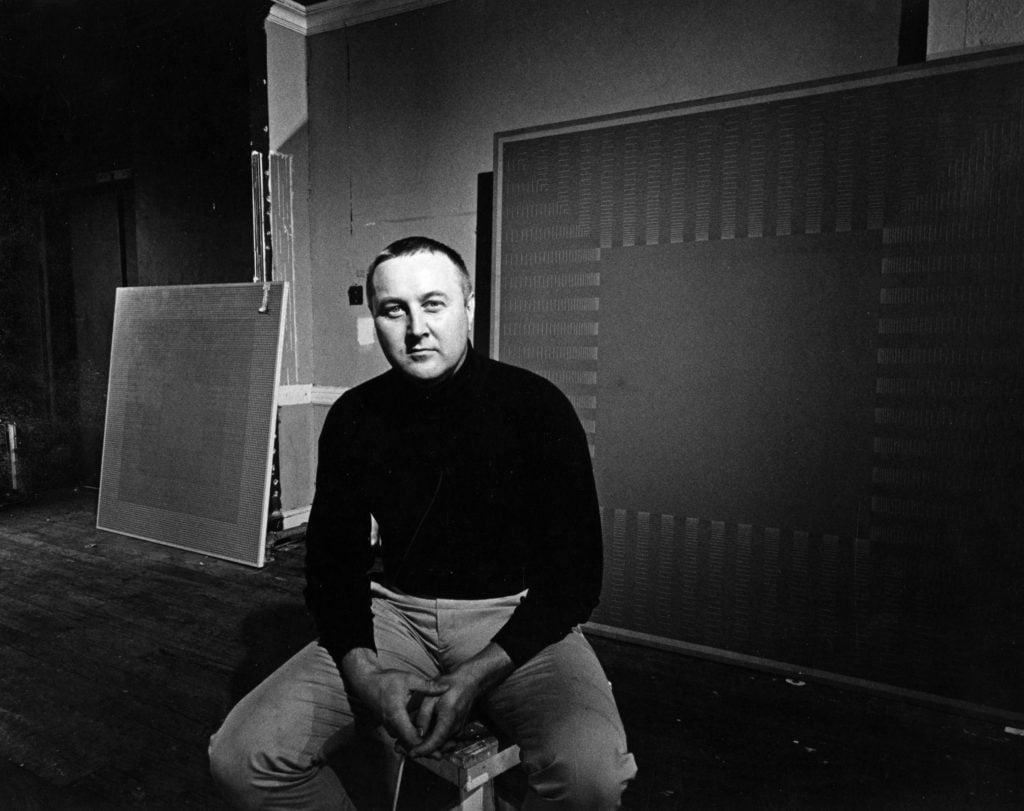People
Richard Anuszkiewicz, an Op-Art Pioneer Who Pushed Geometric Abstraction to Illusory Ends, Has Died at 89
The American artist was one of Op-Art’s most dedicated practitioners.

The American artist was one of Op-Art’s most dedicated practitioners.

Taylor Dafoe

Richard Anuszkiewicz, an American painter whose meticulous, mathematical approach to color and composition made him one of Op-Art’s biggest stars, died at his home in Englewood, New Jersey on May 19—just four days before his 90th birthday.
The artist’s son confirmed the news to the New York Times. A cause of death was not provided.
Anuszkiewicz rose to prominence in the early 1960s as part of a group of artists, including Julian Stanczak and Bridget Riley, that pushed the minimal geometric forms color field to more illusory ends, creating paintings that played on perception. The artist was included in the Museum of Modern Art’s “The Responsive Eye,” the 1965 exhibition now considered to be the capstone of the Op-Art movement. At the time, critic Grace Glueck suggested Anuszkiewicz “might already be called an op old master.”
“I’m interested in making something romantic out of a very, very mechanistic geometry,” Anuskiewicz once said. “Geometry and color represent to me an idealized classical place that’s very clear and very pure.”
Anuszkiewicz was born in Erie, Pennsylvania, in 1930, the son of Polish immigrants. A talented artist at a young age, he won scholarships to the Cleveland Institute of Art. After graduating in 1953, he furthered his pursuits at the Yale University School of Art and Architecture, where he studied with Josef Albers—a relationship that would come to loom large in Anuszkiewicz’s career. It was Albers who, a couple of years after Anuszkiewicz’s graduation from Yale, inspired the young artist to move away from the kind of drab realism he had, until that point, dabbled in, and to instead experiment with the limits of color and formal abstraction.
“[Albers] shook up my whole way of thinking and it took me a couple of years to get myself reassembled,” Anuszkiewicz said in a 1970 interview.
After returning to Ohio to earn a degree in education from Kent State University, Anuszkiewicz moved to New York in 1957, where his work was received with mixed responses from gallerists.
“Abstract Expressionism was very popular,” he once said. “My things were very hard-edged, very strong in color—a use of color that nobody was using. Everybody would say, ‘Oh, they are nice, but so hard to look at. They hurt my eyes.’”
When he did secure his first gallery show in 1959, a lack of sales during the initial weeks found the owner threatening to take the exhibition down before Alfred H. Barr Jr., MoMA’s founding director, purchased two paintings, including one for the museum’s collection.
After that, Anuszkiewicz’s career took off. He was included in major exhibitions at the Whitney Museum of American Art and MoMA before the “The Responsive Eye” opened in ‘65, and he had his first career survey at the Cleveland Museum of Art in 1966. Though many of his Op-Art contemporaries experimented with other styles, Anuszkiewicz remained dedicated to the exploration of line and color for his entire life, favoring a more intellectual approach to his work.
“We put too much emphasis on the hand,” he said in 1970. “And the mind is something that can never be replaced. You can never create any new art unless it’s created by the human mind.”